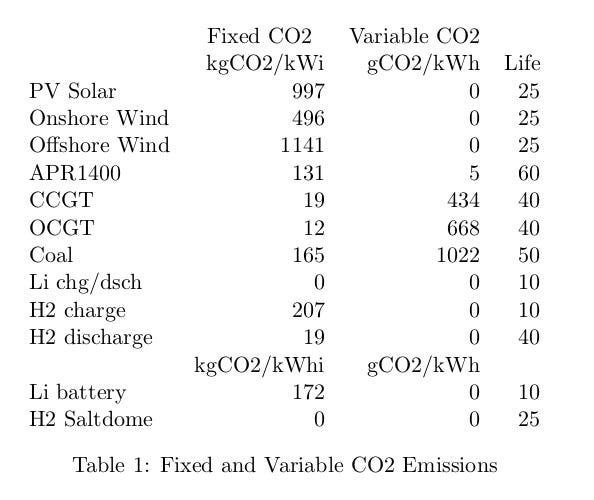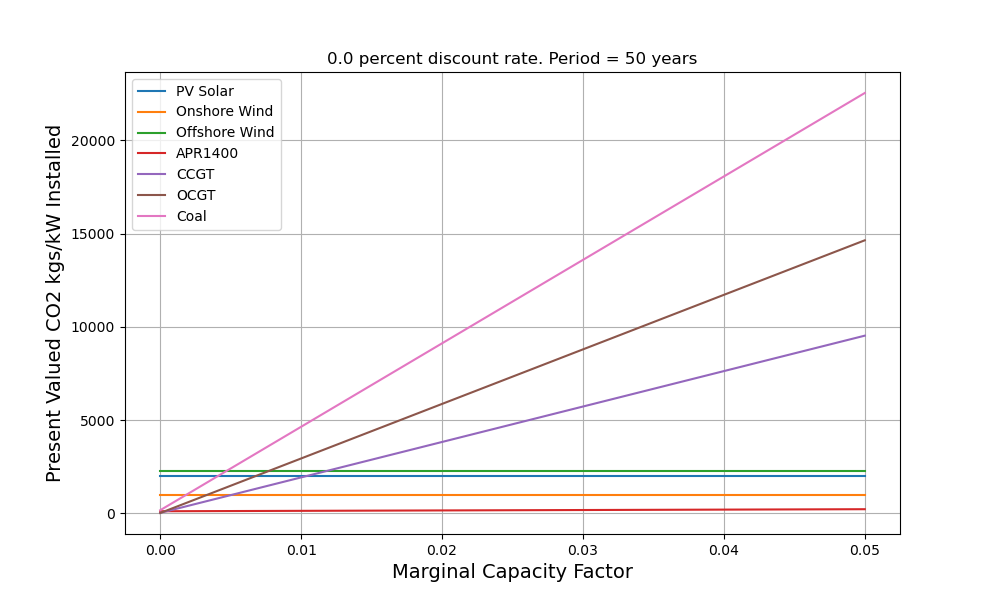A Zero Fossil Grid Makes Sense for Nobody
At times, the choir can be a trifle, dare I say, obtuse. Several of the more honest members have challenged my statement that, if the marginal capacity factor is low enough, solar, wind, and nuclear are high CO2 sources of power and gas is a low CO2 source. It's time to put some numbers on that claim. Table 1 shows the GKG Grid Model's current Base Case estimates of fixed and variable CO2 emissions for a range of technologies. Fixed CO2 are the CO2 emissions associated with providing the capacity. Variable CO2 are the emissions created when the plant generates a kWh of electricity.
These guesstimates were arrived at via whatever method I could come up with. Often it was simply reversing the process by which the misleading gCO2/kWh number was computed, for sources for which nearly all the emissions are fixed. For example, the PV solar numbers are based on the UNECE median estimate of 36.7 gCO2/kWh and the UNECE average capacity factor of 0.124 and life of 25 years. I assumed all the PV CO2 is fixed and a discount rate of 6%, and worked the present value calc backwards.
For now let's not argue about the accuracy of these numbers, some of which are clearly wrong. Obviously, there are emissions associated with leaching a salt dome, providing the plumbing, and maintaining it. Instead let's accept these numbers for now and ask how much CO2 will each power source emit as a function of capacity factor.
Figure 1 answers that question assuming a discount rate of 5%. Nothing particularly surprising here. The CO2 emissions from the combustion of fossil fuel dominate the figure.
But lets zoom in on the low end, Figure 2. Once the capacity factor gets below about 5%, Combined Cycle Gas Turbine has lower present valued CO2 emissions than PV solar. If I had used Chinese PV numbers, the source of most PV panels, the crossover would have been higher.
Figure 1. Prevent valued CO2 emissions as a function of capacity factor.
Figure 2. The Low End of Figure 1.
Why is this important? On most grids, peakers operate at capacity factors below 5%, often well below 5%. What counts in evaluating peaking capacity is the marginal capacity factor, the capacity factor of the next unit of capacity. As you add capacity to the grid, the marginal capacity factor inexorably decreases, and keeps decreasing. Some peakers operate for only a few hours per year. Their CO2 emissions are almost all fixed.
Thanks to their anemic energy densities, wind and solar are resource hogs. Their fixed CO2 emissions are 50 or more times higher than gas. If you think CO2 emissions are harmful, the last thing you would do is use wind/solar as peakers, even if they were dispatchable.
Nuclear is dispatchable and has far lower fixed CO2 than wind/solar. But nuclear's fixed emissions are 6 to 10 times higher than gas. Even nuclear emits more CO2 than gas, once the marginal capacity factors get below about 0.5%.
Some people may be uncomfortable with discounting CO2. For me, it is obvious that, if CO2 emissions are harmful, there is value in putting them off. But for those who disagree, Figure 3 is a repeat of Figure 2, except the discount rate has been set to zero.
Figure 3. Prevent valued CO2 emissions as a function of capacity factor, Zero Discount Rate.
The change in discount rate has moved the cross-over points down considerably, but the cross-over points are still there, And once you get below the cross-over point, the cost of going with the more polluting source has increased. Some will say what about batteries or green hydrogen? Both storage options have fairly high fixed CO2, Table 1. At best you are trading wind/solar fixed CO2 for storage fixed CO2. The cross-over points are still there.
In every case, eventually we will reach the point where shunning fossil fuel increases CO2. This is true, even if we take the myopic and horribly misguided view, that increasing the cost of electricity will not increase non-grid CO2 emissions. Anyone who believes that CO2 is an existential threat to humanity should want some fossil capacity on the grid. A zero fossil grid makes sense for nobody.






Right on. As we say in Earth Is a Nuclear Planet, the world must decarbonize as fast as humanely possible. Natural gas is a giant improvement over burning coal, wood, and dung. Demonizing all carbon fuels helps no one.
What if we were to assume a much lower fixed cost on nuclear, like maybe a ThorCon instead of an APR1400? Couldn't we get the cost of nuclear comparable to gas? Then it would make sense to just go all nuclear, and save the cost of gas peakers. To put it in simple terms - if I'm still around 10 years from now, with low-cost nuclear readily available, and I needed an extra 100 MW to cover those demand peaks, would I order a slightly larger MSR in an existing building, or add a new building with some gas peakers. With solar PV, we have no choice. We are now adding 200 MW of solar, backed by 200 MW of gas.